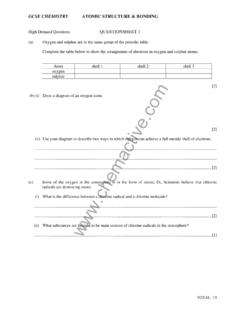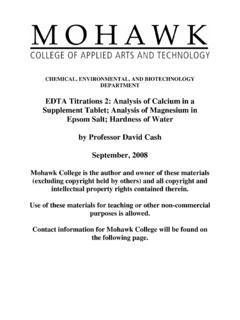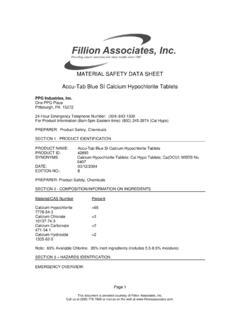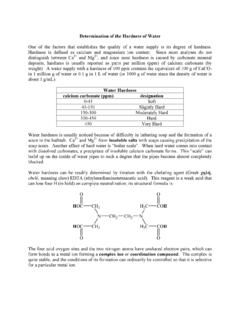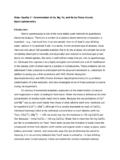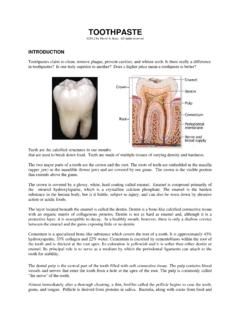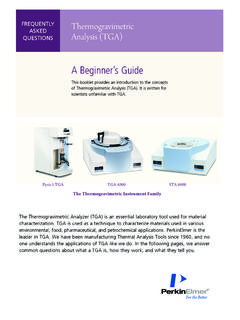Transcription of www.chemactive
1 GCSE CHEMISTRY RATES OF REACTION. High Demand Questions QUESTIONSHEET 1. calcium carbonate reacts with dilute hydrochloric acid to produce the gas carbon dioxide. The table below gives the results from a reaction when 40 cm3 dilute hydrochloric acid was added to one marble chip ( calcium carbonate) at room temperature of 20oC. The calcium carbonate was in excess. One of the results in the table is unreliable. Mass of flask and contents (g). om time (min) 0 1 2 3 4 5 6 7 8 9. (i) On the grid below plot a graph of the results shown in the table above. Draw a smooth curve through the reliable points and label it A. [3]. ctiv ma Mass of flask and he contents (g). ww 0. Time (min). ( ). GCSE CHEMISTRY RATES OF REACTIONS. QUESTIONSHEET 1 CONTINUED. (ii) Sketch carefully on the grid the graph that would be obtained if: I. the same reaction was carried out at a temperature of 50oC.
2 Label this graph B. [2]. II. when an identical piece of calcium carbonate was reacted with only 20 cm3 of the dilute acid. Label this graph C. [2]. (iii) Explain your answer to part (ii) I, in terms of particle collision.. om .. [3]. ctiv ma he ww TOTAL / 10. GCSE CHEMISTRY RATES OF REACTION. High Demand Questions QUESTIONSHEET 2. Some chemical reactions may take place twice as quickly if their temperature is raised by 10oC. (a) If a particular reaction takes 32 minutes at 20oC, how long will it take if the temperature is raised to 50oC? .. [2]. om (b) Plot a graph of temperature against time taken to complete the reaction. [3]. ctiv Temperature/ oC. ma he Time / min ww (c) Explain why the line on your graph does not meet either axis.. [2]. TOTAL / 7. GCSE CHEMISTRY RATES OF REACTIONS. High Demand Questions QUESTIONSHEET 3. carbonates react with acids to produce a salt, carbon dioxide and water.
3 (a) The equation describes the reaction between calcium carbonate and hydrochloric acid. CaCO3 + 2 HCl CaCl2 + CO2 + H2O. (i) Add state symbols to complete the equation. [1]. (ii) Name the salt produced in this reaction. om .. [1]. (iii) Use the relative atomic masses C =12, Ca = 40 and O=16 to calculate the relative formula mass of calcium carbonate. Show your working.. [1]. ctiv (iv) How much carbon dioxide can be produced from: A 100 g calcium carbonate? .. ma .. [2]. B 1 g calcium carbonate? .. he .. [1]. (b) A student wished to measure the production of carbon dioxide in the above reaction. She considered the two methods outlined in the diagram. Method A Method B. boiling ww add tube 25 cm3. 1g with hydrochloric calcium 25 cm3. acid carbonate hydrochloric acid weigh immediately weigh leave for 2 minutes pour acid into beaker, replace boiling tube in beaker reweigh leave for 2 minutes reweigh ( ).
4 GCSE CHEMISTRY RATES OF REACTION. QUESTIONSHEET 3 CONTINUED. (i) Before carrying out the experiment, she performed the calculation in part (a) (iv) B of this question. Suggest how this information could be of use to her.. [2]. om (ii) Explain why, of the two methods shown, method B would provide a more reliable estimate of the amount of carbon dioxide produced during the reaction.. ctiv .. [2]. ma he ww TOTAL / 10. GCSE CHEMISTRY RATES OF REACTIONS. High Demand Questions QUESTIONSHEET 4. Raj's chemistry teacher puts a beaker of sodium thiosulphate on the windowsill. Raj can clearly see a tree on the school field through the beaker. The teacher adds hydrochloric acid to the beaker. After 120 seconds Raj cannot see the tree although he is looking carefully. (a) Explain why.. [2]. The teacher repeats the experiment with three other classes.
5 The tree disappears from view at different times. om Time for tree to disappear Class in seconds 9X 120. 9Y 200. 9Z ctiv 150. The three experiments were identical except for the day on which they were done. (b) Which class did the experiment: - (i) on a warm spring day? ma .. [1]. (ii) during a summer heat wave? he .. [1]. (iii) on a January day when the school heating was not working well? .. [1]. The following year the local group of schools agree to do the same experiment on the same day under exactly the same conditions using the same chemicals. They look at objects that are the same distance away. ww The results are: - School Time for tree to disappear in seconds St Peter's 110. St Paul's 100. St Mary's 150. The teachers tested the chemicals used. They found that the sodium thiosulphate was of different concentration in each school.
6 (c)(i) Which school had the strongest solution? .. [1]. ( ). GCSE CHEMISTRY RATES OF REACTION. QUESTIONSHEET 4 CONTINUED. (ii) Give reasons for your answer.. [2]. Hanif decides to use an ultraviolet lamp and an electric motor powered by a photoelectric cell. (d) How could he use this equipment to measure the cloudiness of the liquid in a more objective way? Draw a diagram of how the equipment might be set up. om .. ctiv ma he [4]. ww TOTAL / 12. GCSE CHEMISTRY RATES OF REACTIONS. High Demand Questions QUESTIONSHEET 5. Cotton is starched to make it easier to weave into denim cloth. Before the cloth is made up into clothing the starch is removed so that it can be more easily sewn. Denim from a newly woven roll is tested to find out the best conditions for the removal of starch using the biological catalyst amylase. A solution of amylase is made up and five equal pieces are cut from the roll of denim.
7 Equal quantities of amylase are added to four of the five pieces in separate beakers. The beakers are kept at temperatures of 20oC, 40oC, 60oC and 80oC respectively for 15 minutes. Afterwards all five pieces are tested for starch. (a) (i) What is a catalyst? om .. [2]. (ii) What is the name given to biological catalysts? .. [1]. (b) (i) Which of the cotton samples would you expect to contain the most starch? ctiv .. [1]. (ii) Explain your answer.. ma .. [3]. he (iii) Which sample would you expect to contain the least starch? .. [1]. (iv) Explain your answer.. ww .. [2]. (v) What chemical is most often used to detect starch? .. [1]. TOTAL / 11. GCSE CHEMISTRY RATES OF REACTION. High Demand Questions QUESTIONSHEET 6. The following equation shows what happens when magnesium ribbon reacts with hydrochloric acid. Mg(s) + 2 HCl(aq) MgCl2(aq) + H2(g).
8 (a) What would you see happening to the magnesium ? .. [1]. (b) 40 cm3 of gas is collected in 10 seconds. What is the rate of reaction? om .. [1]. (c) How would the rate compare if you used very dilute hydrochloric acid? Explain why.. [2]. ctiv (d) State two ways in which the reaction could be speeded up besides changing the concentration of hydrochloric acid.. ma .. [2]. (e) Calculate how many moles of hydrogen gas are collected.. he .. [2]. [24 dm3 is the volume of 1 mole of gas at room temperature]. ww TOTAL / 8. GCSE CHEMISTRY RATES OF REACTIONS. High Demand Questions QUESTIONSHEET 7. When M sodium thiosulphate solution (Na2S2O3(aq)) is added to hydrochloric acid, sulphur is formed. (a) What would you observe during the reaction? .. [1]. (b) What other products are formed? .. [2]. om (c) Apart from heating it, how else could you speed up the reaction?
9 How would this work? .. [2]. The following results table was obtained by mixing various amounts of sodium thiosulphate solution, water and 1 M hydrochloric acid. ctiv Na2S2O3(aq) 50 40 30 20 10. Volume H2O(l) 0 10 20 30 40. (cm3) HCl(aq) 5 5 5 5 5. Reaction Time (s) 5 13 27 56 3 min ma (d) (i) Plot a graph of the results [3]. he ww ( ). GCSE CHEMISTRY RATES OF REACTION. QUESTIONSHEET 7 CONTINUED. (ii) Which variable are you testing? .. [1]. (iii) Why is the volume of acid kept the same? .. [1]. (iv) What would you observe during the reaction? .. [1]. om ctiv ma he ww TOTAL / 11. GCSE CHEMISTRY RATES OF REACTIONS. High Demand Questions QUESTIONSHEET 8. Yoghurt is made from milk. Yoghurt contains lactic acid formed from lactose, the sugar present in milk. Recently a new type of yoghurt has appeared in the shops in which bacteria from Russian cosmonauts has been used in the process.
10 (a) Describe a test to show that an acid is formed when milk is turned into yoghurt. State the result of the test.. [2]. om (b) For all practical purposes, a solution of lactose does not change into lactic acid. Adding bacteria increases the rate of reaction. What is meant by the phrase rate of reaction'? .. [2]. (c) Why does the addition of bacteria have this effect? ctiv .. [1]. (d) Describe or draw diagrams to show what is happening to individual molecules of lactose in the reaction to form lactic acid molecules in yoghurt. ma .. he ww [3]. (e) After a while the rate of formation of lactic acid decreases. Why is this? .. [1]. (f) The yoghurt milk mixture is heated to about effect does this have on the rate of the production of lactic acid? Explain your answer.. [2]. TOTAL / 11. GCSE CHEMISTRY RATES OF REACTION. Medium Demand Questions QUESTIONSHEET 9.
